Lee and Jackson in the National Cathedral
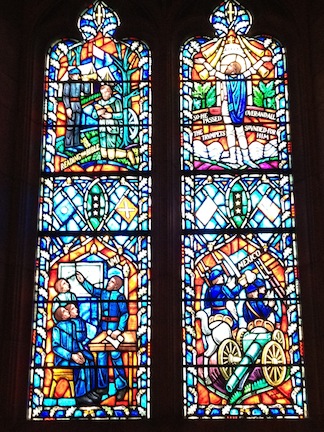 The technicolor hush that fills the National Cathedral in Washington D.C. seems both vibrant and subdued. I don’t know how quiet can be so colorful. The silence beams down from the massive stained glass windows overhead, but the effect on me, standing on the cathedral floor, feels more like the soft flutter of autumn leaves.
The technicolor hush that fills the National Cathedral in Washington D.C. seems both vibrant and subdued. I don’t know how quiet can be so colorful. The silence beams down from the massive stained glass windows overhead, but the effect on me, standing on the cathedral floor, feels more like the soft flutter of autumn leaves.
I’m here not to gape at the giant windows that tower above but, instead, to tuck myself away along one of the corridors of alcoves that flanks the main chamber. One small bay after another, granite pods masoned into gothic arches and trims.
I’ve come here to this great monument to our national spirit because it’s also the site of my favorite Lee-Jackson memorial. Here, if anywhere, live Gods and Generals.
The first time I saw the Memorial Bay dedicated to Robert E. Lee and Stonewall Jackson, it nearly floored me. How the two Confederate icons found their way into the National Cathedral boggled my mind. Yet there they stand in stained glass, each in his own niche, side by side. Lee and Jackson, the Christian soldiers.
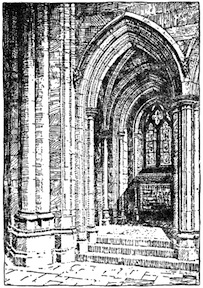
Each niche in the Memorial Bay measures nine feet from side to side, fourteen feet from entrance to window, and twenty feet from marble floor to vaulted ceiling. The Bay is located near the front of the cathedral’s nave, along the south wall—“a prominent place near the center of the church where thousands pass each week,” noted L. M. Bashinsky, the U.D.C. chairwoman who oversaw the windows’ completion.
According to The History of the United Daughters of the Confederacy, Parts One and Two, the memorial “was born in the ‘mind and heart of a Texas daughter, Mrs. Oscar Barthold’” in 1931, who originally proposed a bronze tablet with a relief portrait of Lee to cost “no more than $1,000.” After “due consideration,” however, the U.D.C. felt it was “better to defer this memorial until others have been completed.”
Another 15 years passed before the effort got up and going again, under the direction of Bashinsky, who shepherded the project through to its dedication in 1953. By that point, the scope of the project had changed dramatically.
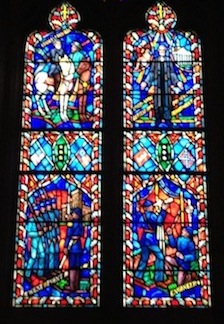 According to Bashinsky, the dean of the cathedral said “only a memorial commensurate with General Lee’s position among the nation’s great men would be acceptable to the Cathedral. In keeping with the memorial to Washington and [Woodrow] Wilson, the Lee Niche was proposed.” (Wilson is buried in the cathedral a few bays away.)
According to Bashinsky, the dean of the cathedral said “only a memorial commensurate with General Lee’s position among the nation’s great men would be acceptable to the Cathedral. In keeping with the memorial to Washington and [Woodrow] Wilson, the Lee Niche was proposed.” (Wilson is buried in the cathedral a few bays away.)
“To Washington, Wilson, Jefferson, and Madison great personal memorials have been erected already,” Bashinsky told U.D.C. members.
Now the opportunity to erect a fitting memorial to Robert E. Lee here in this great sanctuary has been presented to the people of the South. By whom else could this work be so significantly or lovingly done? Where else could it be so advantageously placed as here, in the city now not only the capital of the United States, but of the world—a mecca for the footsteps of posterity—here where thousands go who will never cross the Potomac to see the South’s veneration of Lee as evidenced at Stratford and Lexington?
Of special appeal to U.D.C. members was the ability to memorialize their organization and the legacy of the Confederacy.
[H]ere, where the nation’s heroes are to be honored side by side, the patriotism of the Confederacy shall have recognition. No boy from either side of the line must ever stand in this great gathering of soldiers and wonder at the absence of a Southern hero. One must be there lest the question be: were the men who wore the Gray really patriots; did they fight for their country to keep it the way their forebears founded it? They were and they did; and, for their sake, their beloved leader must have place where the great spirits of our nation’s history are to be enshrined.
The project evolved from a $1,000 plaque into a $110,000 “Memorial Bay consisting of two niches—one for Lee and the other for Jackson. Thus, “the U.D.C. had the privilege of thus honoring two great Christian soldiers,” the organization’s history said. Nearly half the money came from non-UDC donors, including Northern philanthropist James Sheldon.
In the U.D.C.’s final report, Bashinsky said
these memorials…in this great temple of worship, dedicated to the glory of God and the good of Mankind, are memorials not only to Robert E. Lee and to ‘Stonewall’ Jackson, to the Confederate Government and the principles for which it stood, but in the years to come, a Memorial to the United Daughters of the Confederacy in America’s Westminster Abbey among the nation’s Great and Good, and will attest to the world our interest in things spiritual and that we passed this Way, the Way of Truth and Light.
Lee’s double-window stands to the left. It depicts scenes of Lee as an engineer, of his time at West Point, of his victory at Chancellorsville, and of as an exemplar of Christian virtue. “Lord lettest now thy servant depart in peace,” it says, with a robed Lee outstretching his arms. Beneath the window, inscribed in stone, is the following legend:
To the Glory of God, all righteous and all merciful, and in undying tribute to the life and witness of Robert Edward Lee, servant of God, leader of men, general-on-chief of the armies of the Confederate States whose compelling sense of duty, serene faith, and unfailing courtesy mark him for all ages as a Christian soldier without fear and without reproach, this memorial bay is gratefully built by the United Daughters of the Confederacy.
Jackson’s double-window stands to the right. Scenes depict him in Mexico, at VMI, kneeling on the battlefield while reading a Bible, and crossing the river. “So he passed over and all the trumpets sounded for him,” it says. Beneath the window is the inscription:
To the Glory of the Lord of Hosts whom he so zealously served and in honored memory of Thomas Jonathan Jackson, lieutenant general, C.S.A., like a stone wall in his steadfastness, swift as lightning, and mighty in battle, he walked humbly before his Creator, whose word was his guide, this bay is erected by the United Daughters of the Confederacy and his admirers from South and North.
Together, the windows represent the most stunning example of Lee-Jackson memorialization I have ever seen.
An organ demonstration starts up, shaking me from my reverie with music as loud as artillery. It’s as if, just for the briefest of moments, the windows have their own soundtrack—some thunderous church standard that might just as well be the Lee-Jackson version of “Ride of the Valkyries.” The feeling passes, and instead, the notes trapped in the alcove press in tighter than the claustrophobic stone. Time to go.
I dip my head in a brief nod. The Confederate chieftains not only made it into the Federal capital after all, they’ve been enshrined there. Part of me is aghast—and part of me remains delighted.
————
Sources:
Bashinsky, L. M. “The Proposed Memorial to General Robert Edward Lee in the Washington Cathedral.” The Virginia Magazine of History and Biography. July 1949. Vol. 57, pp. 301–6.
The History of the United Daughters of the Confederacy, Parts One and Two. Kessinger Publishing Company. pp 279-281.

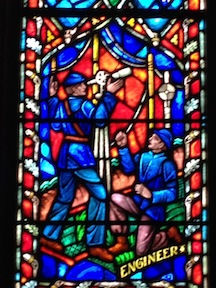

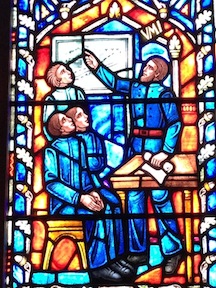
You KNOW I love this kind of story! I just wish I’d been able to scoop you. Is the National Cathedral open now? I thought it was still closed. And hey! Where are the Grant and Sherman windows??? (and the Elmer Ellsworth window . . . just sayin’).
Huzzah for the color writers!!
I too am surprised at the windows. Interesting that they hang in the capitol of the US. Perhaps it is time for some windows to Grant, etc. in a cathedral in Richmond. After all, bygones be bygones and fair is fair. Somehow I don’t think that will ever happen.
The UDC commissioned those windows and if there is such an organization on the Union side, I would appeal to them. I am a southerner and would not know about their organizations.
Sincerely,
Karla S Bridges
And now, they must be removed…as must all evidence of the Confederacy. History must be cleansed.
How long till the haters discover them and demand their removal?
Why is the Very Rev. Gary Hall trying to wage war on our history?
He called for the removal of the Lee and Jackson windows that have been in the National Cathedral since 1953 because they have a Confederate Battle Flag in them … since 1953.
In a sermon from this past June 28th delivered by the Very Rev. Gary Hall he said: “There simply is no excuse for the nation’s most visible church to display a symbol of racism, slavery, and oppression. None.”
Why doesn’t he also remove the Lewis and Clark windows? They were both slave owners and even took a slave with them on their trip.
Why doesn’t he remove the Thomas Jefferson window that’s in the National Cathedral? He was a slave master.
Why doesn’t he remove the James Madison window that’s in the National Cathedral? He was a slave master.
Why doesn’t he remove the tomb of known racist and segregationist Woodrow Wilson from the National Cathedral? Is it because Dean Francis Sayre was the grandson of the known racist and segregationist Woodrow Wilson?
Why doesn’t he remove the statue of the slave master George Washington that’s in the National Cathedral?
Why is the National Cathedral still in Washington DC, a place named after a slave master?
Why is there a memorial to General Nelson Miles the man that slaughtered countless native Americans honored in the National Cathedral?
Why does the National Cathedral still accept money with slave masters on it? You’re good with pennies, $5’s and $10’s, everything else has a slave master on it. That goes for the gift shop and the entry fees you charge tourists too.
Why is the National Cathedral’s Elementary School named after the retirement home of Confederate President Jefferson Davis?
Did the Very Rev. Gary Hall mean what he said, or is this all for the news media and a new capital campaign?
Lee and Jackson did not slaughter those innocents in Charleston, nor did the Confederate Battle Flag. Lee and Jackson would pray with us for them and their families if not lead those prayers themselves.
Please leave the Lee and Jackson windows as they were.
James Boyd
“Who controls the past controls the future: who controls the present controls the past.”
– George Orwell, 1984
Preach it, Brother!
Watch C-SPAN panel with Ray Suarez as moderator: history is messy, Martha F. Barkley, Charleston, SC
More info on the C-SPAN broadcast, please?
Panel discussion held at the Washington cathedral recently with audience questions about the stained glass windows honoring Jackson and Lee…confederate flags removed and further changes possible: google cspan coverage to view full hour or more of history and US racial perspectives, Martha F. Barkley, Charleston, SC
I just listened to All Things Considered on NPR ‘A foundation has doubled their $250 million pledge to diversify monuments in the U.S.’ They talked about the windows that replaced these two. I understand why they did this. But they must not have read the article above. Because they left out anything that was good about these windows. The replacement windows are a contemporary view of how people, with the best intentions, want people to see the world today. They did an excellent job of doing this. But, its also an example of something to make people feel better like ‘Hands Across America’ Which was a very real charity event that took place on May 25, 1986, dreamt up by Ken Kragen. It to was a great gesture—but you can’t actually cure hunger and all that. To sum this up the replacement windows are for better or worse like ‘Hands Across America.’ only give hope for a better future.